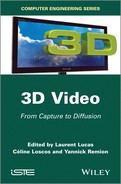PART 1. 3D ACQUISITION OF SCENES
1.3. Stereopsis and 3D physiological aspects
Chapter 2: Digital Cameras: Definitions and Principles
2.2. Capturing light: physical fundamentals
2.4. Cameras, human vision and color
2.5. Improving current performance
Chapter 3: Multiview Acquisition Systems
3.1. Introduction: what is a multiview acquisition system?
3.3. Lateral or directional multiview systems
3.4. Global or omnidirectional multiview systems
Chapter 4: Shooting and Viewing Geometries in 3DTV
4.2. The geometry of 3D viewing
4.3. The geometry of 3D shooting
4.4. Geometric impact of the 3D workflow
4.5. Specification methodology for multiscopic shooting
Chapter 5: Camera Calibration: Geometric and Colorimetric Correction
5.5. Colorimetric considerations in cameras
PART 2. DESCRIPTION/ RECONSTRUCTION OF 3D SCENES
Chapter 6: Feature Points Detection and Image Matching
6.3. Feature point descriptors
Chapter 7: Multi- and Stereoscopic Matching, Depth and Disparity
7.2. Difficulties, primitives and stereoscopic matching
7.3. Simplified geometry and disparity
7.4. A description of stereoscopic and multiscopic methods
7.5. Methods for explicitly accounting for occlusions
Chapter 8: 3D Scene Reconstruction and Structuring
8.2. Silhouette-based reconstruction
8.4. Temporally structuring reconstructions
Chapter 9: Synthesizing Intermediary Viewpoints
9.2. Viewpoint synthesis by interpolation and extrapolation
9.3. Inpainting uncovered zones
PART 3. STANDARDS AND COMPRESSION OF 3D VIDEO
Chapter 10: Multiview Video Coding (MVC)
10.2. Specific approaches to stereoscopy
Chapter 11: 3D Mesh Compression
11.2. Compression basics: rate-distortion trade-off
11.3. Multiresolution coding of surface meshes
11.4. Topological and progressive coding
11.5. Mesh sequence compression
11.6. Quality evaluation: classic and perceptual metrics
Chapter 12: Coding Methods for Depth Videos
12.2. Analyzing the characteristics of a depth map
Chapter 13: StereoscopicWatermarking
13.2. Constraints of stereoscopic video watermarking
13.3. State of the art for stereoscopic content watermarking
PART 4. RENDERING AND 3D DISPLAY
Chapter 14: HD 3DTV and Autostereoscopy
14.2. Technological principles
14.3. Design of mixing filters
14.4. View generation and interleaving
Chapter 15: Augmented and/or Mixed Reality
15.2. Real-time pose computation
Chapter 16: Visual Comfort and Fatigue in Stereoscopy
16.2. Visual comfort and fatigue: definitions and indications
16.3. Signs and symptoms of fatigue and discomfort
16.4. Sources of visual fatigue and discomfort
16.5. Application to 3D content and technologies
16.6. Predicting visual fatigue and discomfort: first models
17.2. The 2D–3D conversion workflow
17.3. Preparing content for conversion
PART 5. IMPLEMENTATION AND OUTLETS
Chapter 18: 3D Model Retrieval
18.2. General principles of shape retrieval
18.3. Global 3D shape descriptors
18.4. 2D view oriented methods
18.5. Local 3D shape descriptors
18.6. Similarity between 3D shapes
18.7. Shape recognition in 3D video
18.8. Evaluation of the performance of indexing methods
Chapter 19: 3D HDR Images and Videos: Acquisition and Restitution
Chapter 20: 3D Visualization for Life Sciences
20.2. Scientific visualization
Chapter 21: 3D Reconstruction of Sport Scenes
21.2. Automatic selection of a region of interest (ROI)
21.4. Matching image features to the geometric model
Chapter 22: Experiments in Live Capture and Transmission of Stereoscopic 3D Video Images
22.2. Retransmissions of various shows
22.3. Retransmissions of surgical operations
22.4. Retransmissions of “steadicam” interviews
22.5. Retransmission of a transatlantic video presentation
